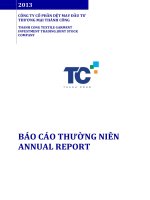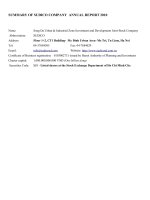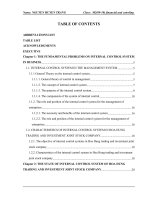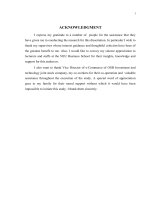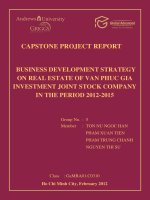Audit report about AMD group investment joint stock company
Bạn đang xem bản rút gọn của tài liệu. Xem và tải ngay bản đầy đủ của tài liệu tại đây (84.63 KB, 12 trang )
CONTENTS
I.
II.
III.
INTRODUCTION
FINANCIAL ANALYSIS
1. Vertical method
a. Balance sheet
b. Income statement
c. Cash flows statement
2. Financial Statement Ratio
a. Liquidity
b. Activity
c. Profitability
d. Coverage
CONCLUSION
I.
INTRODUCTION
AMD Group Investment Joint Stock Company
Launched in 2007 ,when Vietnam's economy were trying to get out of the
way of small business to advance to the investment activities, production
and sales of depth and a larger scale, AMD Group focuses to provide
services: training, consultancy, research and management. By combining
advanced scientific management of the world with the practical conditions
in Vietnam, the Group launched the AMD solutions have helped our
customers to stand firm and developed in the context of the economy are
significant changes and are suffering significant impacts from the financial
crisis led to a global recession.
The growth of customers means that AMD Group confirmed its strong
position on the market. Our team of young and enthusiastic leadership and
group dynamics always grasp investment opportunities, and quickly put
AMD Group grown to become a diversified investment group craft projects
with large-scale investment and owns the brands reputation in domestic
and foreign markets.
Currently AMD Group focusing on the main areas of activity are:
+ Consulting - Training - Research
+ Investment tech
+ Business facilities equipment and Services Commercial
+ Education and training
+ Ecotourism
+ Mining
Guideline for the AMD Group is the application of modern science and
technology and advanced management technology to provide customers
with innovative products and services, in line with the most effective and
lowest cost. AMD Group apply sustainable development strategy on the
basis of control of resources, proactively for and minimize risks from the
system of macro policy and market change, comply with the law and
administrative rules to ensure safe development, actively embrace the
opportunities of investment.
In addition, the AMD Group always focuses on the human element,
considered as human is the most valuable asset and is the deciding
factor for its development. The Group constantly recruiting, training staff
are qualified, enthusiastic and professional ethics.
With the commitment to maximize the benefit for the customer, the
AMD Group always striven to provide the products or services have the
most perfect value for clients, affirms the brand in and outside the
country.
II.
FINANCIAL ANALYSIS
1. Vertical method
a. Balance sheet
AMD Group Investment Joint Stock Company
Common-size Balance sheet for 2014 and 2015
(VND million)
ASSETS
In 2014
Current assets
Cash and cash
equivalents
Short-term
investments
Short-term
receivables
Inventories
Other current assets
Non-current assets
In 2015
214,715
226,624
15,956
23,781
55,867
1,949
120,229
127,492
15,450
70,203
7,214
3,199
246,154
278,800
40,593
4,770
Fixed assets
Investment
properties
Long-term
investments
Total assets
39,859
84,838
460,869
505,424
Liabilities
125,366
146,386
Short -term liabilities
118,071
139,197
7,295
7,188
Owner's equity
320,964
359,039
Charter capital
300,000
300,000
Retained earnings
20,701
40,442
Minority interest
14,539
Long-term liabilities
Total owner's equity
and liabilities
b.
460,869
505,424
Income statement
Net revenue
Cost of goods sold
Gross profit
In 2014
477,368
450,785
In 2015
1,030,151
970,733
Financial income
Financial expenses
Selling expenses
General and
Administrative expenses
Operating profit
Other profit
Profit/Loss of
investments in
associates and joint
ventures
Profit before tax
Net profit after tax
Profit after tax for
shareholders of the
parent company
Earnings per share
(VND)
c.
Cash Flows Statement
26,584
20,974
541
59,418
2,294
437
1,189
492
20,474
25,352
25,944
34,839
1,352
301
26,704
35,140
17,852
25,042
17,423
24,225
CashFlow Direct
I. CASH FLOWS FROM
OPERATING ACTIVITIES
1. Cash receipts from
sale of goods, provision
of services and other
revenue
2. Cash paid to suppliers
for goods and services
3. Cash paid to
employees
4. Interest paid
5. Corporate income tax
paid
6. Other receipts from
operating activities
7. Other payments for
operating activities
Net cash flows from
operating activities
II. CASH FLOWS FROM
INVESTING ACTIVITIES
1. Payment for fixed
assets, constructions
and other long-term
assets
2. Receipts from
disposal of fixed assets
and other long-term
assets
3. Loans, purchases of
other entities' debt
instruments
4. Receipts from loan
repayments, sale of
other entities' debt
instruments
5. Payments for
investment in other
entities
6. Collections on
investment in other
entities
7. Dividends, interest
and profit received
In 2015
In 2014
1,238,264
500,057
(1,182,408)
(501,621)
(11,807)
(6,522)
(287)
(252)
(4,698)
(6,156)
26,609
352,215
(45,222)
(311,077)
20,451
26,644
(1,281)
(3,855)
600
(147,060)
(265,800)
191,178
210,222
(45,665)
(282,188)
31,000
1,908
10,115
2.
Financial Statement Ratio
Liquidity:
Liquidity measures the ease with which AMD Group Investment jsc
can meet their financial obligations with the liquid assets available to
them. There are some ratio:
a.
Current ratio =
This measures short-term debt-paying ability
ii. Quick or acid-test ratio =
This measures immediate short-term liquidity
iii. Current cash debt coverage =
This measures a company’s ability to pay of its current liabilities in a
given year from its operations
i.
Liquidity ratio
In 2014
In 2015
Current ratio
1.71
1,55
Quick or acid-test ratio
1.59
1,07
Current cash debt
coverage
0,21
0,14
Current ratio > 1 so the company is running quite well and can afford to
repay the current debts at maturity . The curent ratio in 2015 was also
lower than 2014. So it can be said that the firm has used lots of capital for
long-term investment and can bring more benefits in the future.
Quick or acid-test ratio is more conservative than the current ratio because
it excludes inventories from current assets. The ratio derives its name
presumably from the fact that assets such as cash and marketable securities
are quick sources of cash. Inventories generally take time to be converted
into cash, and if they have to be sold quickly, the company may have to
accept a lower price than book value of these inventories. As a result, they
are justifiably excluded from assets that are ready sources of immediate
cash.
The current cash debt coverage droped down thought 2 year in the row.
b. Activity:
Activity ratios measure a firm's ability to convert different accounts
within its balance sheets into cash or sales. Activity ratios measure the
relative efficiency of a firm based on its use of its assets, leverage or
other such balance sheet items and are important in determining
whether a company's management is doing a good enough job of
generating revenues and cash from its resources.
i. Accounts Receivable turnover =
This measures liquidity of receivables
• Days of receivable =
ii. Inventory turnover =
This measures liquidity of inventory
• Days of inventory =
iv. Asset turnover =
Measures how efficiently assets are used to generate sales
Activity ratio
2014
2015
Accounts Receivable
turnover
3.97
8,08
Days of receivable
91,94
45,17
Inventory turnover
29,18
13,83
Days of inventory
12,5
26,39
Asset turnover
1.04
2,04
Accounts receivable turnover is an activity ratio that measures how many
times a business can turn its accounts receivable into cash during a period.
In other words, the accounts receivable turnover ratio measures how many
times a business can collect its average accounts receivable during the year.
Account Receivable turnover had the upward trend over 2 years. And the
day of receivable is droped throught 2 year => This is a good sign for the
firm
The inventory turnover measure how efficient the company sold out. The
inventory turnover had the downward trend from 2014 to 2015. It was a
negative impact to AMD group
The asset turnover ratio is a measure of how efficiency a company’s assets
are in generating revenue. It measures the amount of VND of revenue
generated by 1 VND of the company’s assets. This ratio increased from 1.04
in 2014 to 2,04 in 2015 . We can use this ratio to compare with other
company
Profitability
Profitability ratios are a class of financial metrics that are used to assess a
business's ability to generate earnings compared to its expenses and other
relevant costs incurred during a specific period of time.
Profit margin on sales =
Return on assets =
Return on equity =
EPS =
c.
•
i.
ii.
iii.
iv.
Profitability
2014
2015
Profit margin on
sales
Return on assets
(%)
Return on equity
(%)
EPS
0.056
0.024
9,84
7,12
6,31
5,01
581
807
IV.
•
i.
ii.
iii.
The profitability ratio measures the earning to investors. The investors tend
to prefer to invest in the company that generates more profitability ratios.
This ratio is the useful to indicate how efficient the company’s performance.
The profit margin defines how well the firm generates the profit from net
sale. And we can see that profit margin on sales is droped from 2014 to
2015
Gross profit of AMD Group went down from 2014 to 2015.
The trend of ROA, ROE is very high in 2014 and But they dropped out
dramatically in 2015. This stituation was the result of the decreasing in net
income.
It was the good news for stockholders of AMD group that EPS of the
company had risen significantly for all 2 years, even the profit in 2015 was
quite not good.
Coverage
The coverage ratio is a measure of a company's ability to meet its financial
obligations. In broad terms, the higher the coverage ratio, the better the
ability of the enterprise to fulfill its obligations to its lenders.
Debt to assets =
Debt to assets is a coverage ratio that defines the total amount of
debt relative to assets.
Cash debt coverage =
This measures a company’s ability to repay its total liability in given
year from its operations
Book value per share =
This measures the amount each share would receive if the company
were liquidated at the amounts reported on the balance sheet
Coverage
2014
2015
Debt to assets
0,272
0.289
Cash debt
coverage
Book value per
share
0.21
0.14
NA
NA
Debt to assets : The higher the ratio, the higher the degree of leverage, and
consequently, financial risk. We can see that the debt to assets is quite
stayable in 2 years
Cash debt coverage is a cash-basis ratio used to evaluate solvency . The cash
debt coverage ratio stood is higher in 2014 than 2015
CONCLUSION
Financial Statement analysis and valuation is used to analyze the
performance of an enterprise in the past along with the economic and
industry situation to measuring the intrinsic value of stock price of that
firm and determine how well the firm performance.
After doing this financial statement forn AMD group investment JSC
we will have a clearer view of the financial situation of the company.
From which to decide whether to invest in the company or not. This
shows the great importance of the financial statement analysis
III.
Reference sources:
/> />
